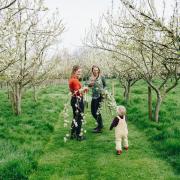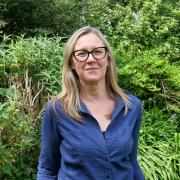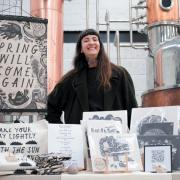With an abundance of history, atmosphere and tranquillity Basing House makes for the ideal attraction and now fresh from renovation, it is the perfect time to bask in the ruins of this integral slice of British History.
How to find Basing House
I arrived at Basing House on what must have been the wettest day of the month, but as I hotfooted it down the canal path to the reception my mood became a lot sunnier as I took in the scenery and the wildlife that surrounded Old Basing House.
Digging up the pastI was quickly welcomed in out of the rain by Operations Manager Claire Capel who, despite only arriving at Basing House herself 10 weeks ago, immediately began to explain to me the importance of the site and the work that has been carried out there.The ruins at Basing House were purchased by Hampshire County Council in the 1970’s and excavations have taken place there for the past 30 years, uncovering some fascinating finds and clues about the house’s intricate past. It has been closed for the past year to allow the team to update the facilities and improve the attraction for visitors and was ready to open in time for the August Bank Holiday.
Part of historyA man who has been involved in the excavation of the ruins for a number of years is curator Alan Turton, he lives on the site above the museum with his wife Nicola who is the chairperson of the Friends of Basing House, a group set up by the couple for local residents and enthusiasts as a way of including the villagers of Basing and encouraging their support. Claire describes Alan as being ‘part of the furniture’ and accredits the vast amount of historical information on display to him. She says: “Over the past year the team has worked hard to improve the visitor attraction aspect of Basing House and we now feel that by developing the visual learning guides and promoting the atmosphere of the ruins we have helped to teach our visitors more about Basing House’s position in history.”
Education, education, educationThe newly refurbished Great Barn, Visitors Centre, Museum and Educational Facilities ensure that the staff at Basing House can offer a fantastic experience for families and most importantly, school children. Claire says: “Being a part of the council means that our links to education are already in place, we work closely with Key Stage 2 and 3 to act as an interactive learning tool and we are very much looking forward to welcoming the students through the door in September.”But the path to success has been anything but smooth as Project Director Peter Jones explains: “Working on a site such as Basing House was always going to be interesting, we have brickwork here that was never designed to be exposed to the elements as most of what is left are basements and foundations, so straight away we are up against the weather and it is almost a race against time to try and maintain the ruins as best we can. We also have bats nesting in the Great Barn and around the site which are a protected species so especially in the re-development we have had to make sure we accommodate the local wildlife and that the overall appearance is in keeping with the area.”
Reap the rewardsHampshire County Council first applied for Lottery funding for Basing House in 2007 and by the end of 2008 they found out they had been successful and had received a grand sum of 1.1 million to develop the project. Describing what it has been like working at Basing House Peter says: “Of course it has been hard work but it is so rewarding, the past three years I have felt so privileged to be able to come to work every day in a place so interesting and beautiful. My background is in archaeology and so for me, working here has been an absolute joy, I am very lucky.”To understand the history of Basing House you really do need to visit the site to learn from the experts but curator Alan Turton tells me that the story is somewhat of an onion, with many different layers to peel back and investigate. Although originally built in 1535 as a palace for Sir William Paulet, the first Marquess of Winchester and Lord Treasurer to Edward VI, Mary I and Elizabeth I, finds have shown that the site has been occupied since before the Roman invasion. The ruins on show today are all that is left of the house that once would have rivalled Hampton Court Palace after Oliver Cromwell stormed the walls during the Civil War in 1645.Any stone left over from the siege was left for the villagers to salvage and many of the houses in Old Basing, and especially the church tower are built from the stone at Basing House. Alan explains: “William Paulet was incredibly successful in his time and, at its peak, Basing House would have been the largest private house in Britain. The likes of Queen Elizabeth I were known to stay here and it was really down to the vast amount of entertaining that the house eventually ran into disrepair before the Civil War.Because of its position it worked very well as a fort during the battles under William’s fifth son John Paulet but was eventually defeated by the Parliamentarians and now all we have left are these fascinating ruins, like pieces of a jigsaw.”
What the visitors think
Ron Timm has visited Basing House once before but was drawn back after visiting his son and daughter-in law Chris and Lynne from his home in South Africa. “Today has been extremely interesting, it’s shown us some of the history which has long been forgotten and has brought to life memories of how we once lived. I think the work they have done here has been magnificent and I look forward to coming back here in the future.”


























